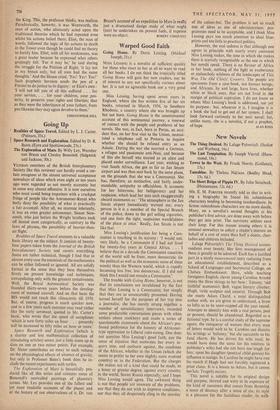Going Up
VETERAN members of the British Interplanetary Society like this reviewer can hardly avoid a cer- tain smugness at the almost universal acceptance nowadays of ideas which even eight or ten years ago were regarded as not merely eccentric but in some way almost offensive. It is now ourselves who must, avoid being impatient with a crackpot fringe of people like the Astronomer-Royal who hotly deny the possibility of what is practically a fait accompli. After all, we murmur tolerantly, it was an even greater astronomer, Simon New- comb, who just before the Wright brothers took off denied most categorically, as contrary to the laws of physics, the possibility of heavier-than- air flight.
Realities of Space Travel amounts to a valuable basic library on the subject. It consists of twenty- four papers taken from the Journal of the British Interplanetary Society, and covers everything. Some are rather technical, though I find that in almost every case the essentials of the mathematics can be either followed or ignored. All are solidly factual in the sense that they base themselves firmly on present knowledge and techniques, extrapolating only with the greatest tentativeness. Well, the Royal Aeronautical Society was founded thirty-seven years before the develop- ment of manned aircraft. And on that basis the BIS would not reach this climacteric till 1970. But, of course, progress is much quicker now, and in a few years such restraint may read rather like the early aeronaut, quoted in Mr. Carter's book, who wrote that the speed of aeroplanes `which is now forty miles an hour . . . presently will be increased to fifty miles an hour or more.'
Space Research and Exploration (which is a shorter and less mathematical collection of stimulating articles) seems just a little more up to date on one or two minor points. For example, Dr. Slater contributes an essay to each volume on the physiological effects of absence of gravity, but only in Professor Bates's book does he in- - elude the recent experiments with turtles.
The Exploration of Mars is beautifully pro- duced like all this series and contains some of Bonestell's unrivalled paintings of planetary scenes. Mr. Ley provides one of the fullest and yet most readable accounts of the planet and of the history of our observations of it. Dr. von Braun's account of an expedition to Mars is really. just a dramatised design study of what might (just) be undertaken on present fuels, if expense










































 Previous page
Previous page